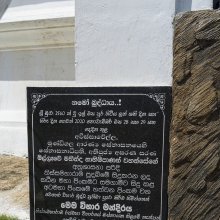Sahodara, Sahōdara, Saha-udara: 15 definitions
Introduction:
Sahodara means something in Hinduism, Sanskrit, the history of ancient India, Marathi, Hindi. If you want to know the exact meaning, history, etymology or English translation of this term then check out the descriptions on this page. Add your comment or reference to a book if you want to contribute to this summary article.
Alternative spellings of this word include Sahodar.
Images (photo gallery)
In Hinduism
Ganitashastra (Mathematics and Algebra)
Source: archive.org: Hindu MathematicsSahodara (सहोदर) represents the number 3 (three) in the “word-numeral system” (bhūtasaṃkhyā), which was used in Sanskrit texts dealing with astronomy, mathematics, metrics, as well as in the dates of inscriptions and manuscripts in ancient Indian literature.—A system of expressing numbers by means of words arranged as in the place-value notation was developed and perfected in India in the early centuries of the Christian era. In this system the numerals [e.g., 3—sahodara] are expressed by names of things, beings or concepts, which, naturally or in accordance with the teaching of the Śāstras, connote numbers.

Ganita (गणित) or Ganitashastra refers to the ancient Indian science of mathematics, algebra, number theory, arithmetic, etc. Closely allied with astronomy, both were commonly taught and studied in universities, even since the 1st millennium BCE. Ganita-shastra also includes ritualistic math-books such as the Shulba-sutras.
India history and geography
Source: Cologne Digital Sanskrit Dictionaries: Indian Epigraphical GlossarySahodara.—(IE 7-1-2), ‘three’ possibly referring to Kuntī's sons. Note: sahodara is defined in the “Indian epigraphical glossary” as it can be found on ancient inscriptions commonly written in Sanskrit, Prakrit or Dravidian languages.

The history of India traces the identification of countries, villages, towns and other regions of India, as well as mythology, zoology, royal dynasties, rulers, tribes, local festivities and traditions and regional languages. Ancient India enjoyed religious freedom and encourages the path of Dharma, a concept common to Buddhism, Hinduism, and Jainism.
Languages of India and abroad
Marathi-English dictionary
Source: DDSA: The Molesworth Marathi and English Dictionarysahōdara (सहोदर).—a (S saha With, udara Belly.) Born of the same mother, coüterine.
Source: DDSA: The Aryabhusan school dictionary, Marathi-Englishsahōdara (सहोदर).—a Couterine, born of the same mother.
Marathi is an Indo-European language having over 70 million native speakers people in (predominantly) Maharashtra India. Marathi, like many other Indo-Aryan languages, evolved from early forms of Prakrit, which itself is a subset of Sanskrit, one of the most ancient languages of the world.
Sanskrit dictionary
Source: DDSA: The practical Sanskrit-English dictionarySahodara (सहोदर).—a uterine brother, brother of whole blood; जनन्यां संस्थितायां तु समं सर्वे सहोदराः (jananyāṃ saṃsthitāyāṃ tu samaṃ sarve sahodarāḥ) Manusmṛti 9.92; सहोदरा कुङ्कुमकेसराणां भवन्ति नूनं कविताविलासाः (sahodarā kuṅkumakesarāṇāṃ bhavanti nūnaṃ kavitāvilāsāḥ) Vikr.1.21.
Derivable forms: sahodaraḥ (सहोदरः).
Sahodara is a Sanskrit compound consisting of the terms saha and udara (उदर).
Source: Cologne Digital Sanskrit Dictionaries: Shabda-Sagara Sanskrit-English DictionarySahodara (सहोदर).—m.
(-raḥ) A brother of whole blood, one by the same father and mother. E. saha with, udara the belly.
Source: Cologne Digital Sanskrit Dictionaries: Benfey Sanskrit-English DictionarySahodara (सहोदर).—m. a brother of whole blood.
Sahodara is a Sanskrit compound consisting of the terms saha and udara (उदर).
Source: Cologne Digital Sanskrit Dictionaries: Cappeller Sanskrit-English DictionarySahodara (सहोदर).—[feminine] ā & ī born from the same womb; a brother or sister of whole blood.
Source: Cologne Digital Sanskrit Dictionaries: Monier-Williams Sanskrit-English Dictionary1) Sahodara (सहोदर):—[from saha] mf(ā and ī)n. co-uterine, born of the same womb, [Manu-smṛti; Mahābhārata] etc.
2) [v.s. ...] closely resembling or similar, [Vikramāṅkadeva-carita, by Bilhaṇa; Bālarāmāyaṇa]
3) [v.s. ...] m. uterine brother, [Mahābhārata; Kāvya literature] etc.
4) [v.s. ...] f(ā or ī). a uterine sister, [Manu-smṛti; Mahābhārata etc.]
Source: Cologne Digital Sanskrit Dictionaries: Yates Sanskrit-English DictionarySahodara (सहोदर):—[saho+dara] (raḥ) 1. m. A brother of whole blood.
Source: DDSA: Paia-sadda-mahannavo; a comprehensive Prakrit Hindi dictionary (S)Sahodara (सहोदर) in the Sanskrit language is related to the Prakrit word: Sahoara.
[Sanskrit to German]
Sanskrit, also spelled संस्कृतम् (saṃskṛtam), is an ancient language of India commonly seen as the grandmother of the Indo-European language family (even English!). Closely allied with Prakrit and Pali, Sanskrit is more exhaustive in both grammar and terms and has the most extensive collection of literature in the world, greatly surpassing its sister-languages Greek and Latin.
Hindi dictionary
Source: DDSA: A practical Hindi-English dictionarySahodara (सहोदर) [Also spelled sahodar]:—(nm) a real brother; (a) real, born of the same mother.
...
Kannada-English dictionary
Source: Alar: Kannada-English corpusSahōdara (ಸಹೋದರ):—[noun] a man or boy as he is related to the another child or other children of his parents; a brother.
Kannada is a Dravidian language (as opposed to the Indo-European language family) mainly spoken in the southwestern region of India.
Nepali dictionary
Source: unoes: Nepali-English Dictionary1) Sahodara (सहोदर):—n. 1. sibling species; 2. full brother;
2) Sahodara (सहोदर):—adj. uterine; born of the same parents;
Nepali is the primary language of the Nepalese people counting almost 20 million native speakers. The country of Nepal is situated in the Himalaya mountain range to the north of India.
See also (Relevant definitions)
Starts with: Sahodara-bhasha, Sahodaragama, Sahotaran.
Query error!
Full-text: Shrisahodara, Amritasahodara, Lakshmisahodara, Sahodar, Sahodara-bhasha, Sahadaram, Saheli, Sahotaran, Bhinnodara, Sahoara, Amritasodara, Sahotpanna, Sahajati, Cakotaran, Sodara, Sahaja, Udara.
Relevant text
Search found 19 books and stories containing Sahodara, Sahōdara, Saha-udara; (plurals include: Sahodaras, Sahōdaras, udaras). You can also click to the full overview containing English textual excerpts. Below are direct links for the most relevant articles:
Devala-smriti (critical study) (by Mukund Lalji Wadekar)
References to section [G] < [Chapter 9 - The distinctive features of the Devalasmriti]
Sahitya-kaumudi by Baladeva Vidyabhushana (by Gaurapada Dāsa)
Text 4.16 < [Chapter 4 - First-rate Poetry]
Text 4.10 < [Chapter 4 - First-rate Poetry]
Text 4.48 < [Chapter 4 - First-rate Poetry]
Notices of Sanskrit Manuscripts (by Rajendralala Mitra)
Ganitatilaka (Sanskrit text and English introduction) (by H. R. Kapadia)
Page 192 < [Sanskrit Text of the Ganitatilaka]
Paumacariya (critical study) (by K. R. Chandra)
5. Relationships mentioned in Paumacariya < [Chapter 7 - Social Conditions]
Trishashti Shalaka Purusha Caritra (by Helen M. Johnson)
Appendix 3.1: additional notes < [Appendices]
Appendix 3.2: new and rare words < [Appendices]
